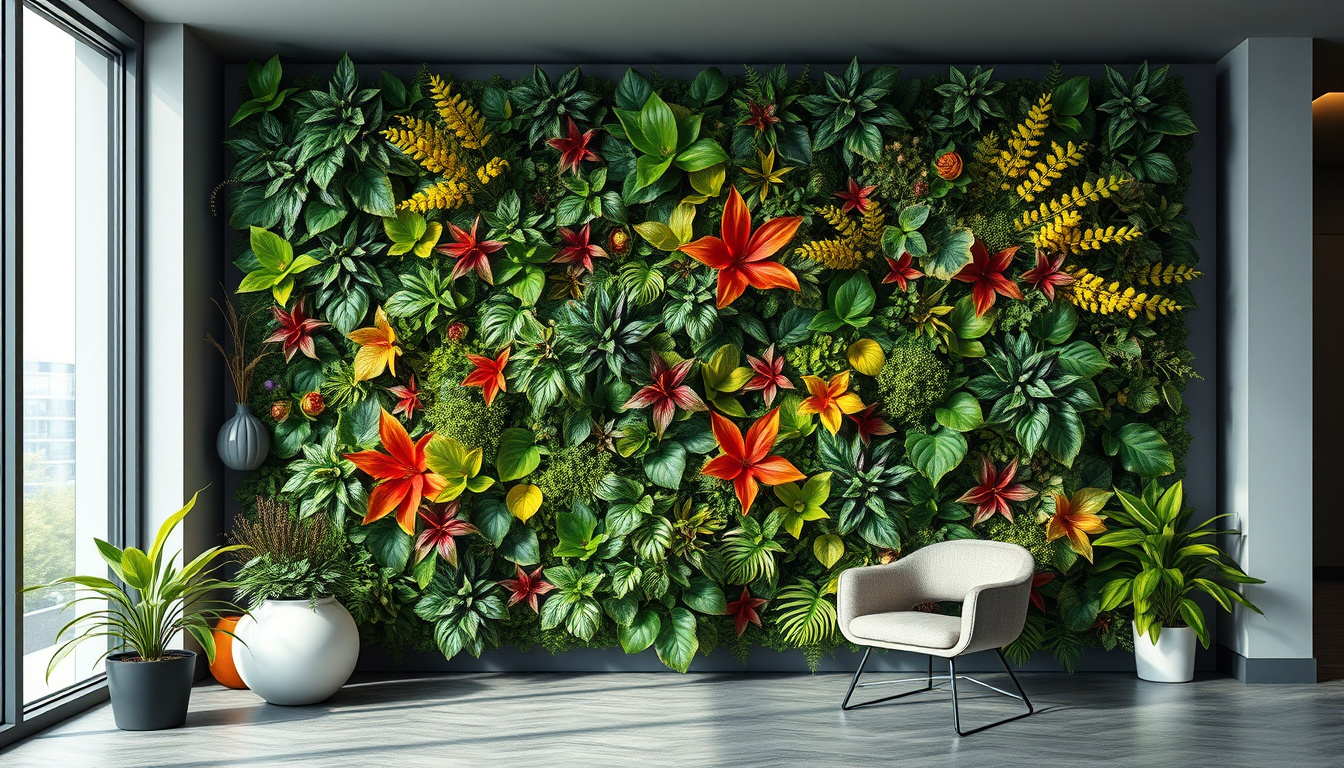
Transform Your Space with a Stunning Faux Plant Wall: The Ultimate Guide to Indoor Greenery
Ever wished to bring the lush feel of nature indoors without the fuss of watering and sunlight? A stunning faux plant wall might just be the solution you’re looking for! Faux plant walls are the perfect way to infuse greenery into your living space, transforming any room into a vibrant sanctuary while eliminating the worries associated with real plants. In this ultimate guide, we’ll explore the benefits of faux plant walls, how to select the perfect greenery, tips on layout and design, as well as installation steps to create your very own indoor paradise. Get ready to elevate your home decor and enjoy the benefits of low-maintenance beauty that a faux plant wall provides!

TLDR (Key Takeaways)
- Faux plant walls offer a low-maintenance and visually appealing alternative to real greenery.
- Selecting the right faux plants is crucial for achieving a natural look in your design.
- Layout and aesthetics play a significant role in enhancing the overall impact of your faux plant wall.
- Proper materials and tools are essential for a successful and durable installation process.
- Regular maintenance tips can help keep your faux plant wall looking vibrant and beautiful over time.
1. Introduction to Faux Plant Walls: Benefits and Appeal
When it comes to enhancing the ambiance of your home, few decor elements have gained as much popularity as the faux plant wall. These captivating installations combine the charm of nature with the ease of maintenance, making them an appealing choice for those seeking a lush, green aesthetic without the hassle of caring for real plants. Faux plant walls can turn a bland space into a vibrant oasis, adding depth and texture to your indoor environment. Not only do they serve as eye-catching backdrops for living areas, offices, or even outdoor settings, but they also come with a myriad of benefits such as allergen-free environments and year-round greenery. As South African homeowners increasingly embrace sustainable living, faux plant walls offer the perfect blend of style, function, and eco-consciousness, allowing you to enjoy the beauty of nature within your space without the ecological footprint of traditional greenery.
2. Choosing the Right Faux Plants for Your Wall
### Choosing the Right Faux Plants for Your Wall
Creating a stunning faux plant wall can instantly elevate the aesthetic of any room while bringing in a refreshing touch of nature. The key to selecting the right faux plants is to consider both the size and style of the space you are working with. Faux plant walls can range from minimalistic to lush, dense arrangements. Here are some tips to guide your selection:
• Assess Your Space: Evaluate the wall's size and the amount of natural light it receives. Larger walls can handle bigger, bolder faux plants like monstera leaves or palms, while smaller spaces may benefit from delicate ferns or trailing ivy that frames the area without overwhelming it.
• Color Coordination: Opt for colors that complement your existing color scheme. Greenery can vary from vibrant tropical greens to more muted, earth-tone shades. Mixing in faux flowers or plant varieties with shades like soft whites or deep purples can add a delightful contrast and bring depth to your faux plant wall.
• Texture Variety: To create visual interest, choose plants with different textures. For example, pairing smooth succulents with the rugged texture of faux eucalyptus can result in an engaging display.
• Lighting Considerations: If your wall is well-lit, you can choose plants with glossy leaves that reflect light beautifully, creating an eye-catching focal point. On the other hand, in darker sections, opting for plants with matte finishes can help balance the overall look.
• Theme Consistency: Ensure that the selected faux plants align with your overall decor theme. Whether you’re leaning towards a rustic farmhouse vibe with cotton branches and sage or a modern tropical style with bright, bold leaves, maintaining a consistent theme will tie your design together.
Finally, don't forget to get creative with arrangements! Layering plants at different heights, using backlighting, or incorporating decorative frames can enhance your faux plant wall even further.
'Nature does not hurry, yet everything is accomplished.' - Lao Tzu
3. Designing Your Faux Plant Wall: Layout and Aesthetics
Designing your faux plant wall is all about balancing layout and aesthetics to create a stunning visual impact in your space. Start by selecting a wall that serves as a focal point—this could be in the living room, hallway, or even in a home office. Next, consider the height and width of your wall when deciding how to arrange your faux plants; a grouped layout can provide depth, while a more scattered arrangement offers a relaxed vibe. Styling Tip: For an organic feel, mix different types of faux plants, such as leafy ferns and blooming succulents, to create layers of texture and color. Ensure you also think about the color palette of your chosen plants. Combining shades of green with pop colors from flowers can elevate your faux plant wall even further. Be mindful of how the plants interact with the surrounding decor—complimentary colors or contrasting tones can create a dynamic effect. Finally, incorporate different sizes of plants to draw the eye up and down the wall, making the space feel taller and more inviting. With these considerations in mind, your faux plant wall will not only be aesthetically pleasing but will also enhance the overall ambiance of your home.

4. Materials and Tools Needed for Installation
When planning to create a stunning faux plant wall, having the right materials and tools is essential for a successful installation. Here’s a list of what you will need:
### Materials:
1. Faux Plants: Choose a mix of greenery, such as ferns, succulents, and vines, to create depth and interest. Make sure to select high-quality faux plants for a more realistic look.
2. Wall Panels or Grids: Opt for lightweight wall panels or wire grids as a base for your faux plant arrangement. These provide a sturdy foundation and allow for easy attachment of plants.
3. Adhesive or Mounting Tape: Depending on your choice of panels, use a strong adhesive or mounting tape for affixing the faux plants securely.
4. Optional Backing Fabric: Consider using a fabric backdrop in a neutral tone to enhance the visual appeal and provide a soft contrast against the greenery.
### Tools:
1. Scissors or Wire Cutters: For trimming faux plants to your desired length and shaping them perfectly.
2. Drill or Screwdriver (if using panels): If your wall panels require screws for secure mounting, have a drill and screwdriver ready.
3. Measuring Tape: To ensure that your faux plant wall fits well in your designated space and is level when installed.
4. Level: Keep everything aligned and straight for a professional finish.
Having these materials and tools at hand will not only streamline your installation process but also ensure that your faux plant wall looks stunning and visually captivating. Remember, the right faux plant wall can breathe life into any room and create a gorgeous focal point without the maintenance of live plants.
5. Step-by-Step Guide to Installing Your Faux Plant Wall
Creating a faux plant wall is a fantastic way to bring a touch of nature indoors without the upkeep that real plants require. In this step-by-step guide, we’ll walk you through the process of installing your very own faux plant wall.
Step 1: Choose Your Location
Select a wall that you want to transform. Consider areas that lack vibrancy or feel a bit lifeless—entryways, living rooms, or even office spaces can greatly benefit from a faux plant wall.
Step 2: Measure the Space
Using a measuring tape, determine the dimensions of the wall space you plan to cover. This will help you calculate how many faux plants and panels you'll need to achieve a balanced look.
Step 3: Gather Your Materials
You will need:
• Faux plant panels (available at decor stores)
• Heavy-duty adhesive or mounting strips
• A utility knife or scissors for trimming
• Optional: Frame or grid structure for added depth
Step 4: Prepare the Wall
Ensure your chosen wall is clean and dry. Any dirt or grease can affect the adhesion of your faux plant panels.
Step 5: Lay Out Your Design
Before attaching anything, arrange the panels on the floor to visualize your design. Experiment with various patterns—overlapping plants or a more uniform grid can produce different effects.
Step 6: Attach the Panels
Starting from one corner, begin adhering each panel to the wall using heavy-duty adhesive or precision mounting strips. Press firmly and hold for a few seconds to ensure they stick well.
Step 7: Trim as Necessary
Once all panels are attached, you can use a utility knife to trim any edges that don’t fit perfectly. Be careful to achieve a smooth finish, and this will make your faux plant wall look professionally installed.
Step 8: Final Touches
Consider adding decorative elements such as fairy lights or picture frames to enhance your faux plant wall further. Lighting can create a cozy ambiance, while the frames will accentuate your greenery.
Styling Tip: Incorporating varying shades of green and a mix of leaf types will create a lush, dynamic wall that captivates your guests and brings your interior to life.
With this guide, you’ll have a stunning faux plant wall that rejuvenates your space while requiring minimal upkeep.
Frequently Asked Questions
What are the benefits of having a faux plant wall?
Faux plant walls offer a low-maintenance way to add greenery to your space without the need for sunlight or constant watering. They also enhance the aesthetic appeal of a room, improve air quality, and can provide sound insulation.
How do I choose the right faux plants for my wall?
When selecting faux plants, consider the colors, textures, and sizes that complement your interior decor. Look for high-quality materials that mimic the appearance of real plants and choose a mix of different species for a more natural look.
What materials do I need to create a faux plant wall?
To create your faux plant wall, you'll need faux plants, a sturdy backing material (like wood or canvas), adhesive or mounting tools, and decorative elements like frames or lighting, depending on your design.
Can I install a faux plant wall by myself, or do I need professional help?
Many people successfully install faux plant walls themselves by following a step-by-step guide. However, if you feel uncomfortable with DIY projects, hiring a professional can ensure a polished and well-executed installation.
How do I maintain my faux plant wall?
Maintaining a faux plant wall is easy; simply dust the plants regularly with a soft cloth or use a vacuum with a brush attachment. For deeper cleans, you can lightly wash them with water and mild soap, but ensure they dry completely to avoid mold.















